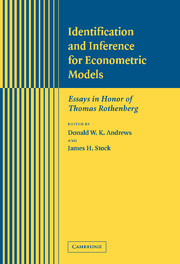Book contents
- Frontmatter
- Contents
- List of Contributors
- Preface
- Part I Identification and Efficient Estimation
- Part II Asymptotic Approximations
- 8 Asymptotic Expansions for Some Semiparametric Program Evaluation Estimators
- 9 Higher-order Improvements of the Parametric Bootstrap for Markov Processes
- 10 The Performance of Empirical Likelihood and Its Generalizations
- 11 Asymptotic Bias for GMM and GEL Estimators with Estimated Nuisance Parameters
- 12 Empirical Evidence Concerning the Finite Sample Performance of EL-type Structural Equation Estimation and Inference Methods
- 13 How Accurate is the Asymptotic Approximation to the Distribution of Realised Variance?
- 14 Testing the Semiparametric Box–Cox Model with the Bootstrap
- Part III Inference Involving Potentially Nonstationary Time Series
- Part IV Nonparametric and Semiparametric Inference
13 - How Accurate is the Asymptotic Approximation to the Distribution of Realised Variance?
Published online by Cambridge University Press: 24 February 2010
- Frontmatter
- Contents
- List of Contributors
- Preface
- Part I Identification and Efficient Estimation
- Part II Asymptotic Approximations
- 8 Asymptotic Expansions for Some Semiparametric Program Evaluation Estimators
- 9 Higher-order Improvements of the Parametric Bootstrap for Markov Processes
- 10 The Performance of Empirical Likelihood and Its Generalizations
- 11 Asymptotic Bias for GMM and GEL Estimators with Estimated Nuisance Parameters
- 12 Empirical Evidence Concerning the Finite Sample Performance of EL-type Structural Equation Estimation and Inference Methods
- 13 How Accurate is the Asymptotic Approximation to the Distribution of Realised Variance?
- 14 Testing the Semiparametric Box–Cox Model with the Bootstrap
- Part III Inference Involving Potentially Nonstationary Time Series
- Part IV Nonparametric and Semiparametric Inference
Summary
ABSTRACT
In this paper we study the reliability of the mixed normal asymptotic distribution of realized variance error, which we have previously derived using the theory of realized power variation. Our experiments suggest that the asymptotics is reliable when we work with the logarithmic transform of the realized variance.
INTRODUCTION
Tom Rothenberg's outstanding teaching and research has raised the level of understanding econometricians have of the asymptotic properties of estimators and testing procedures used in economics. His frequent trips away from the United States, and his particular kindness to research students during his academic visits, has spread his influence changing the way we carry out theoretical econometric research. This paper touches on some of Tom's research interests. It will look at the effectiveness of an asymptotic theory. His influential paper Rothenberg (1984) was devoted to issues of this type.
The Model
This paper assesses the accuracy of the mixed normal asymptotic approximation to the distribution of realized variance (that is the sum of squares of financial returns) we recently derived in Barndorff-Nielsen and Shephard (2002) and extended in Barndorff-Nielsen and Shephard (2003, 2004). This theory assumes a flexible stochastic volatility (SV) model for log prices.
In the SV model for log prices a basic Brownian motion is generalized to allow the volatility term to vary over time.
Information
- Type
- Chapter
- Information
- Identification and Inference for Econometric ModelsEssays in Honor of Thomas Rothenberg, pp. 306 - 331Publisher: Cambridge University PressPrint publication year: 2005
Accessibility standard: Unknown
Why this information is here
This section outlines the accessibility features of this content - including support for screen readers, full keyboard navigation and high-contrast display options. This may not be relevant for you.Accessibility Information
- 46
- Cited by
